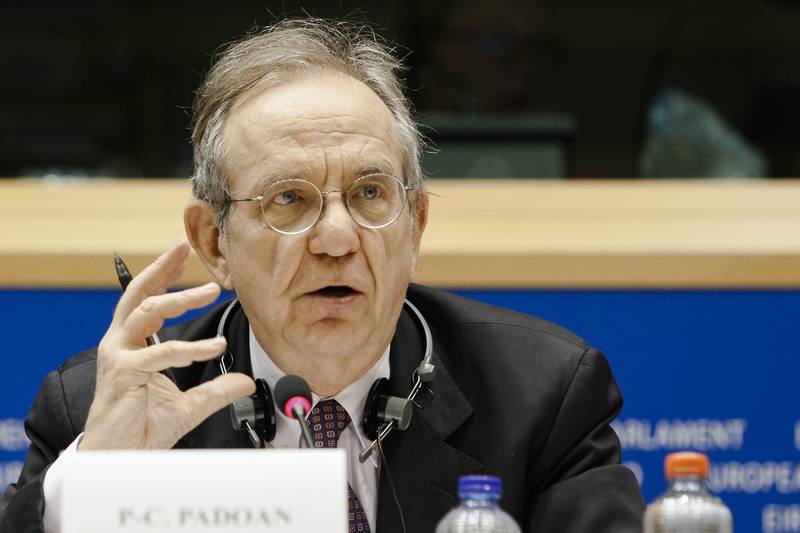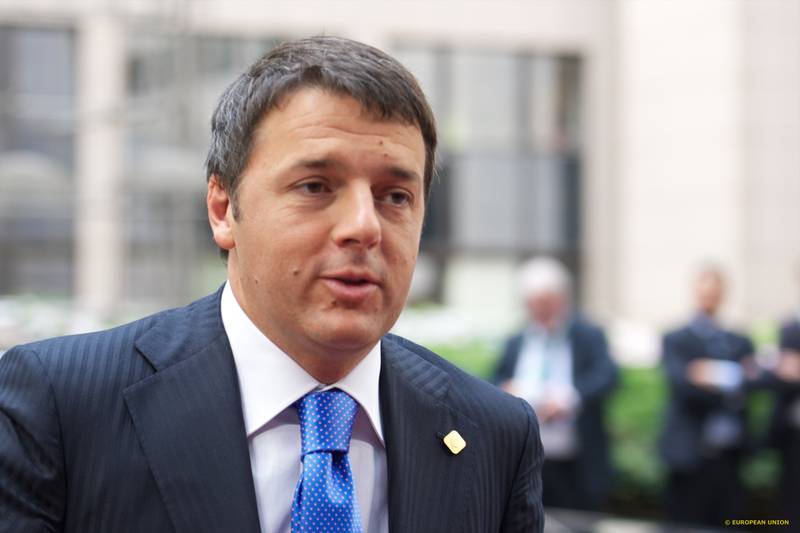No More Austerity. It's Time for Investments
Adelina Marini, January 22, 2015
 Does the EU need changes and what should they be? New legislation or a change of the behaviour when applying the already agreed? Those are questions that have again been raised in the Union because of the uneven economic recovery and the not good economic perspectives the EU is facing both as a Community and as individual member states. "Now is the time to rethink deeply economic governance because we're not yet out of the big crisis. Europe needs not only to be more flexible but to update its governance to deal with future crises", Italy's Finance Minister Pier Carlo Padoan told the economic committee of the European Parliament when reporting on the achievements of the six-month rotating presidency of the Council. Currently, in the Union are being considered changes in three directions - the six-pack and the two-pack; new report on the future of the euro area; a change of approach when implementing the existing legislation.
Does the EU need changes and what should they be? New legislation or a change of the behaviour when applying the already agreed? Those are questions that have again been raised in the Union because of the uneven economic recovery and the not good economic perspectives the EU is facing both as a Community and as individual member states. "Now is the time to rethink deeply economic governance because we're not yet out of the big crisis. Europe needs not only to be more flexible but to update its governance to deal with future crises", Italy's Finance Minister Pier Carlo Padoan told the economic committee of the European Parliament when reporting on the achievements of the six-month rotating presidency of the Council. Currently, in the Union are being considered changes in three directions - the six-pack and the two-pack; new report on the future of the euro area; a change of approach when implementing the existing legislation.
What to do with the six-pack and the two-pack?
These are two legislative packages which introduced in 2011 and 2013 unprecedented deepening of the coordination among the member states in terms of economic policies and budget planning. The packages that have become popular as a package of 6 legislative proposals and a package of 2 proposals (six-pack and two-pack) upgraded the Stability and Growth Pact (SGP) or the so called economic governance of the EU. The first package covers all the EU member states. It brings light onto their problems and discusses them at supranational level. The Commission makes detailed analyses of the economic situation of all the 28 member states and gives them specific recommendations to remove the imbalances it found, excessive deficits or public debts. The six-pack introduces two main categories - a preventive arm and a corrective arm. It also introduces the concept of deviation from the mid-term budget objective or a deviation from the path toward it.
When the six-pack entered into force in December 2011 23 of the then 27 EU member states were included in an excessive deficit procedure (EDP). As an effect of the 2008 crisis (defined as a debt crisis), the budget deficits and public debts of many of the countries bubbled harshly. In the end of August 2014, their number fell to 11 out of 28. This has had an impact on the overall budget deficit as well - it dropped from 4.5% of GDP in 2011 to 3% in 2014. Alas, in terms of public debts not only there is no decline but they have even increased in some member states. The two packages were adopted in a record fast time for the usual pace of work of the EU, although this coincided with the increased functions of the European Parliament which demanded much more discussions and negotiations. The effort was huge and took almost two years but the purpose was to restore confidence in the EU and the euro area at large against the backdrop of the falling member states like a domino which threatened the very survival of the common currency.
The six-pack has already turned into a traditional exercise while the two-pack has been applied for two years only and is something that no one in the EU has got accustomed to yet. Moreover, the period when this legislation came into effect coincided with the crisis fatigue and everything that stems from it. This is the reason why in the end of last year a talk has begun on changes of the two packages but there are still no specific ideas, apart from insisting to loosen the belts. The European Commission has presented in end-2014 a review of the work of the two packages and concluded that, at this stage, it is too early to draw any conclusions from the efficiency of the regulations. The problem is not only in the short period of functioning, especially for the two-pack, but also that they have been applied in a period of severe economic crisis. This means that the rules have not been tested in a normal situation yet. Furthermore, it is not clear whether these rules could have been an impediment for the economic recovery in some cases.
And although the Commission conclusion is that, at this stage, it is early to say where exactly the economic governance does not work well, still, some problems have been singled out in the report. The biggest is the implementation of the country-specific recommendations. According to a report of the EP economic committee, the member states are implementing only 10-15% of the Commission's recommendations. This is a very serious problem and is the biggest conclusion that can be drawn from the work of the enhanced economic governance - no rules can sustain the pressure of domestic politics. The key for the good work of any supranational legislation is to be accepted as a national goal and to be applied with a background thought about the community not just daily politics. This is precisely what the EU has been failing in the past years. That is why the structural reforms have turned into a major topic in 2014 with a main speaker on it the ECB chief, Mario Draghi.
On 12 January, Minister Padoan underlined in front of the economic committee in EP that the implementation of structural reforms is crucial but national parliaments should have a leading role. "Each time we design national policies in the euro area we need not to forget that there is a national dimension and a European dimension", he told the MEPs. It is not hard to find proof because the map of the uneven economic recovery coincides with the map of structural reforms. The member states that are in the process or have already done deep reforms enjoy economic growth, as in some cases that growth is pretty dynamic. And vice versa - the countries that are stuck and their growth is moving around the statistical error or are in a long recession are generally those that have not dared to conduct reforms. That is why, the main task, according to Padoan, is to find a way how to make national reforms "spill over" to other countries just as it happened in the beginning of the crisis - it spilled over or infected other countries depending on the level of economic interconnectedness between them.
And although it is said in the review of the efficiency of the EU economic governance that it is too early to say how effective the two packages are, in the Annual Growth Survey for 2015, which is also part of the economic governance, the European Commission says that the European Semester has to be reformed to increase the efficiency of the coordination of economic policies at EU level through increased transparency and improvement of the "ownership" of all participants. According to the Commission's experience with the two packages, there is still no ownership of the European legislation at national level. This is the reason why the level of implementation of the country-specific recommendations is so low. In other words, an end should be put to "us vs Brussels" and vice versa. What Brussels says is, in fact, what the capitals tell each other in Brussels. The problem is, though, that as a consequence of the crisis, domestic politics is eating away the supra-national efforts and is eroding the Community as such, as euinside recently wrote. This will be the biggest political and economic challenge for the EU in 2015.
Renzi's flexibility
 And as the conversation about what, how and when should be changed is still in germ, the Commission has proposed another solution - instead of undertaking new legislative actions to use to the maximum what is already available. This is the famous Renzi amendment which the Italian prime minister insisted very much on from the day he was elected and when his country took over the rotating presidency of the Council on 1 July last year. His main demand is the countries that conduct deep structural reforms to receive a more favourable attitude when applying the fiscal rules. Moreover, if these countries make investments, they should not be taken into account when calculating the budget deficit and the debt.
And as the conversation about what, how and when should be changed is still in germ, the Commission has proposed another solution - instead of undertaking new legislative actions to use to the maximum what is already available. This is the famous Renzi amendment which the Italian prime minister insisted very much on from the day he was elected and when his country took over the rotating presidency of the Council on 1 July last year. His main demand is the countries that conduct deep structural reforms to receive a more favourable attitude when applying the fiscal rules. Moreover, if these countries make investments, they should not be taken into account when calculating the budget deficit and the debt.
As they promised when elected, Juncker's Commission presented a strategic document which is supposed to serve as an incentive to the member states to do their part of the bargain - to implement on national level what they have agreed on supra-national level. On 13 January, the Commission presented a communication which provides guidelines how to use the existing rules without changing them. The so called "interpretation of the Stability and Growth Pact" enters into force immediately and contains very good news for those who have chosen the path of reforms. There are also good news for those who still do not dare to undertake deep reforms but their success depends on the way these rules will be interpreted in the affected capitals.
Many of the proposed interpretations in the communication are more or less known already and are mainly aimed at abandoning the austerity policy but with strict adherence to the fiscal rules. The good news for Mr Renzi is that the contributions or guarantees of the member states in the future investment fund will not be calculated in the budget deficit or debt. This means that an EDP procedure will not be triggered if the budget deficit surpasses 3% because of the contributions to the fund. The same is valid for the public debt. This approach will be used also for national co-financing of individual projects, including possible investment platforms. This covers all innovative financial tools like loans, debt instruments or bonds.
Large-scale investments which are defined as commensurate to big structural reforms, too, under certain conditions, can be accepted for temporary deviation from the mid-term objective (MTO). This, however, will be applied only for countries that are in the preventive arm of the SGP, which means they are not subject to sanctions. The Commission proposes flexibility also in terms of the "investment clause" - countries that are making public investments with a positive, direct and verifiable effect on growth and public finances to receive favourable treatment. This principle was already applied in 2013 for Bulgaria and in 2014 for Bulgaria, Romania and Slovakia. In order for a country to take advantage of the investment clause, however, it has to be in a recession or its gross domestic product to be below its potential. This is the case of Croatia which has been in a recession for 6 years.
The costs for co-financing should not be a substitute for national investments to avoid a decline of the overall quantity of public investments. The investment clause will not be applied unconditionally. The member states will have to compensate for it in 4 years for the allowed deviation. The investment clause will be valid also for countries whose deviation from the MTO is due to national co-financing of projects co-funded by the EU budget. This is precisely what Croatia complained about in the first year of its EU membership and afterwards. The then minister of finance said that the deficit bubbled significantly because of the country's contribution to the EU budget and because of national co-financing.
The countries that are doing serious structural reforms can also deviate temporarily from their MTOs but not without some conditionality. The most important of the conditions is the reforms to be really serious and deep. Such is the reform of the pension system, for instance. In addition, the reforms must have a direct positive effect on the economic growth and the public finances. This means either saving costs as a result of the reforms, for example in the pension system or the healthcare system, or increase revenues. Reforms must be absolutely completed. For the purpose, the member states have to offer a detailed programme for structural reforms which must contain specific timetable and expected results. If the programme is not being implemented, then the temporary deviation from the MTO (which cannot exceed 0.5% of the GDP) will be cancelled. Apart from that, the Commission could demand a suspension of EU funds and if a country is from the euro area the Commission could even impose a fine.
Under such a test are France, Italy and Belgium which received an extension until March under the two-pack (to correct their budgetary plans in line with the fiscal rules). Italy is in a process of deep reforms and is very likely that the Commission will apply the entire possible flexibility of the SGP on it. Is this going to happen to France is arguable because the country is in the corrective arm, which means it is in EDP and the possibilities for flexibility are very limited. Unless the country would decide to take part in the investment fund, but this would not remove the need of structural reforms, the most urgent of which are the reform of the labour market, the administrative burden, the judiciary. There was an idea the structural reforms to be approved by the national parliament before a country is to allowed any deviation but this is practically a change of the rules.
As a reward for a country that is doing structural reforms is also the possibility an open EDP to be closed down. This is especially valid in cases when a pension reform is under way related, for instance, to the introduction of a multi-pillar system with a mandatory and fully financed pillar. In such a situation, the Commission will partially or entirely ignore the costs for the pension reform when assessing the budget deficit. This situation, however, raises the opposite question - what to do with the countries that are removing the second pillar or are temporarily transferring funds to the first. euinside did not receive an answer from the European Commission by the time this article was published. The question is important because several countries have already applied this method. Croatia has last year transferred funds from the second pillar to the first in order to try and meet the budget deficit targets. Hungary, too, did a similar thing several years ago and the issue is currently hotly debated in Bulgaria.
What will be the future of the euro area?
The third direction where a debate is forthcoming on possible changes of the economic policy is related to the future of the Economic and Monetary Union (EMU). More specifically, a new or adapted vision about the future. In June 2012, when the second wave of huge changes was agreed (after the six-pack), namely the creation of a banking union, the four presidents (of the Commission, Eurogroup, European Council and ECB) were tasked to develop a vision about the future of the EMU. Then two versions were proposed. One by the four presidents under the leadership of the then chief of the European Council, Herman Van Rompuy, and a solo action by the ex-president of the Commission, Jose Manuel Barroso. Both consist of three phases for the development of the zone of the common currency, as in the third both documents foresee partial changes of the EU treaties but the report Herman Van Rompuy presented is less ambitious than Barroso's vision.
The third phase is the most problematic one because it envisages treaty change to enable the creation of a separate budget of the eurozone which to "absorb shocks". Apart from a budget, a centralised decision-making is envisaged in the areas of taxation and employment. Since then the integrationist moods in EU have grown cold which is why the leaders of the member states are giving up on the vision of Barroso, Rompuy, Juncker and Draghi and have tasked the current chiefs of the European institutions to draw a new one. This was supposed to be one of the main topics of the December EU summit but because of the concept of the new European Council President Donald Tusk for less topics on the agenda and for shorter summits this issue was left out.
It will be on the agenda of the leaders at their informal summit in February in Brussels. The configuration in which the new report will be drawn is a bit different. It again involves Jean-Claude Juncker and Mario Draghi, but the former is now a president of the European Commission, not the Eurogroup. The newcomers are Donald Tusk as European Council president and Jeroen Dijsselbloem as head of the Eurogroup. The information related to the future document is scarce at this stage. So far entirely or partially have been realised the first two stages of the old report. Those are completion of the reform of the economic governance (by the time what remained to be done was to adopt the two-pack and the supervisory mechanism for banks) which has been done. The second phase envisaged predominantly a completion of the banking union with the construction of a second pillar - the single resolution mechanism. This process ended in the end of last year.
How exactly will the third phase look like is the main question because any deeper changes require treaty change. Traditionally, in the EU there is no appetite for renegotiation because this would open the Pandora's box at a time when to Britain it is a priority number one to ensure deep reform of the EU. This is so important to the UK that it has become a matter of staying or leaving the EU. Also a problem is the current political situation in many of the member states where populist, nationalistic and eurosceptic parties are gaining speed and in some countries they are even leading political forces. A possible opening of the treaties could lead practically to a break-up of the Union as we know it today. The situation has been additionally complicated by the problems with Greece.
If flexibility wins
The proposed flexibility by the Commission could prove EU's salvation because any long-term visions and reforms of the treaty would not resolve the main problem of the EU - the member states to implement what they have agreed themselves. This is the conclusion from all the other discussions about changes - the enhanced economic governance cannot work in a one-way street nor any changes in the euro area could make the member states work for the interest not only of their own citizens but also for the interest of the Union.
 Klaus Regling | © Council of the EU
Klaus Regling | © Council of the EU Mario Centeno | © Council of the EU
Mario Centeno | © Council of the EU Mario Centeno | © Council of the EU
Mario Centeno | © Council of the EU